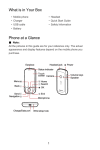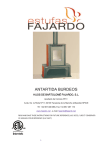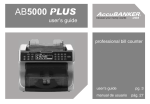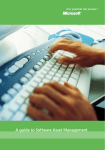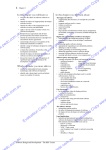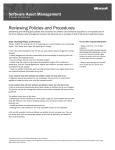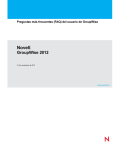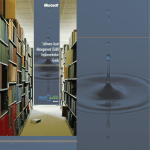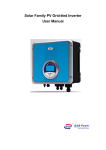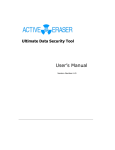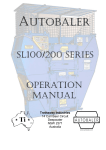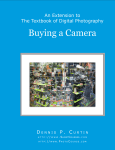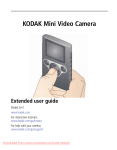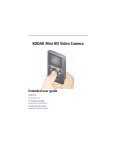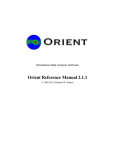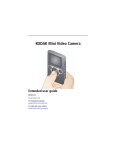Download Intellectual Property and General Licensing
Transcript
Intellectual Property and General Licensing Intellectual Property and General Licensing 2 Contents Intellectual Property General Licensing Questions 4–5 6 – 14 Certificate of Authenticity Specifics 15 – 16 Guidelines for Second-hand PCs 17 – 18 Product Activation 19 – 23 Software Asset Management 24 – 26 Types of Software Piracy 27 – 30 Microsoft Anti-Counterfeiting Security Features 31 – 33 Resources 34 – 35 Contents 3 Intellectual property What is Intellectual Property? Intellectual Property is a group of legislative and common law rights affording protection to creative and intellectual effort. Intellectual property protection covers literary, artistic and musical works (including computer programs); and inventions, scientific discoveries, industrial designs, trademarks, trade secrets (confidential information). The four most common forms of intellectual property are copyright, patent, trade secrets (confidential information) and trademarks. Importance of Intellectual Property Protection In the new economy, the most important determinant of the profitability of a business is its “intellectual capital” or the knowledge, information and experience that can be used to create wealth. More than ever before, nations are relying on information-intensive products to fuel economic growth. As a result, the prosperity of many national economies depends more on the knowledge and intellect of people and less on the hours of their labour. Knowledge is the capital and intellect is the means of production that will drive economic growth in the century ahead. Industries such as computer software, film, music performing and recording and publishing industries are based almost entirely on the development and sale of their intellectual capital. These industries stand or fall on the strength of intellectual property protection provided by legal systems. Intellectual property 4 Computer programs in some form or another underlie every action taken in cyberspace and are therefore the fundamental building block of the new economy. From a global perspective, the computer software industry employs 1.35 million people and produces US$175 billion in worldwide revenue annually. But while the information economy is soaring, so is intellectual property theft and information piracy. The long-term health of the global information economy rests upon the ability of the public and private sectors to work together to protect intellectual property rights against the growing problems of technology theft worldwide. Intellectual property protection provides the legal framework to safeguard intellectual capital. 5 General Licensing Questions What is a software license? A software license grants a person (or company) the legal right to use a software program. For each software program you use, you need a license granted to it and proper documentation evidencing that license. Microsoft offers many licensing programs designed to meet your every need. The software licenses that accompany these programs will vary. What is an End User License Agreement (EULA)? The End User License Agreement outlines the terms and conditions of use for the software program you have acquired. For retail (Full Packaged) software, the license agreement is between Microsoft and the end customer; for OEM (Original Equipment Manufacturer) software, the license agreement is between the PC manufacturer and the end customer. Where do I find my End User License Agreement? The End User License Agreement (EULA) may be found in one of several different locations, depending on your Microsoft software. The three most common locations for the license agreement are: 1) printed on a separate piece of paper that accompanies the software; 2) printed in the User’s Manual, usually on the inside front cover or the first page of the manual; or 3) located online within the software product. How are Microsoft’s End User License Agreements delivered? EULAs may be included with Microsoft software products in online or hard copy form. Please note that Microsoft does not authorise the bulk distribution of single EULAs on a stand-alone basis. Counterfeiters, however, have been known to distribute EULAs in this General Licensing Questions 6 form in the marketplace. If you have questions about the legitimacy of your Microsoft’s End User License Agreement, please contact the Microsoft Anti-Piracy Hotline on 1800 63 99 63 (Australia) or 0800 74 72 29 (New Zealand). What is a Certificate of Authenticity (COA)? The Certificate of Authenticity (COA) assists you to determine whether the Microsoft software you have acquired is genuine. The COA is not the license, but forms part of the documentation to prove ownership of your software. For further information, please refer to the section in this booklet entitled “Certificate of Authenticity”. What is the difference between OEM (Original Equipment Manufacturer) and retail (Full Packaged Product) software? OEM software is licensed for use only on the computer system on which it was installed originally. However, retail software may be transferred, in its entirety, to a different computer system as long as the person transferring the software deletes all copies of the software from their personal computer. Another difference is the identity of the licensor; for retail software, the license agreement is between Microsoft and the end customer. For OEM software, the license agreement is between the PC manufacturer and the end customer. Another important distinction is that OEM operating system software is intended and marked for distribution with new PCs or other new non-peripheral computer hardware, while OEM application software is intended and marked for distribution with a new PC only. OEM software is packaged in shrink-wrapping, while retail software is intended for distribution on a stand-alone basis and is packaged in brightly coloured boxes containing a CD-ROM, product manual, Certificate of Authenticity and End User License Agreement. 7 What is Microsoft Volume Licensing? Microsoft Volume Licensing is the licensing method available to customers who wish to acquire multiple copies of Microsoft software. Volume licensing programs provide flexible volume software license purchasing options for corporate customers and other customer types including Academic and Government. Customers who participate in Microsoft’s Volume Licensing programs can realise savings over retail Full Packaged Product and enjoy the flexibility of forecasting in order to budget for software acquisitions. For customers who need more than one copy of Microsoft software, acquisition through volume licensing can be an effective way to reduce their total cost of ownership (TCO). For each license acquired, the customer is granted permission to use a copy of the software. We provide volume license opportunities through a variety of channels to give customers greater access and choice. How can I be assured that my Microsoft software is genuine and fully licensed? Your Microsoft software is fully licensed only if: • The software is genuine. Recognising the anti-counterfeiting security features in genuine Microsoft products and looking out for them when buying software will help give you peace of mind and avoid the risks associated with non-genuine Microsoft products. For further details on whether your software or hardware is genuine, visit www.microsoft.com/australia/piracy/howtotell/default.aspx • A COA is included. In the case of OEM software, it will be affixed to the chassis once installed or, in the case of retail software, it is affixed to the outside of the box. 8 • The media, manuals and other components are distributed as authorised by Microsoft. By purchasing Microsoft software from Authorised Distributors, you can ensure that you are receiving genuine and current Microsoft software. How do I establish that I have a legal license? Microsoft strongly recommends that you keep the following in order to establish that you have genuine and fully licensed software: • All software and applicable components, including media and manuals. • Certificate of Authenticity (COA). • End User License Agreement (EULA), which explains the terms and conditions of use of software. • Purchase orders/receipts, to demonstrate the purchase of your licenses. If you have purchased licenses through a Microsoft Volume Licensing program, you should retain your License Agreement and license confirmation(s). What happens if I use my Microsoft software without a license? If software is copied or not legally licensed, you are not only, potentially, putting your own home PC or organisation’s PC network at risk, you are also breaking the law. If you acquire software that isn’t genuine, you could find that the software is defective, missing valuable code and can affect the security of your PC. Registered users of genuine software enjoy reliable and secure software and receive added value through technical product support and software upgrades. 9 Further, by using software that is inappropriately licensed, you are risking your business and professional reputation. Have legal confidence that your business uses genuine and licensed software. Can I make a second copy of my Microsoft Office software for my portable computer? The terms and conditions between different versions of the Microsoft Office software product may differ; therefore, it is best to check your EULA and review the terms and conditions of use of your particular product. Can I make a second copy of my operating system software, for my home, work or portable computer? No. The right to make a second copy of a Microsoft software product applies only to some application products and not to operating system software. Is it legal for me to sell a software license that I have bought and used? Yes, as long as you follow the terms of transfer outlined in your license agreement. For example, in relation to retail Microsoft software, you may transfer your rights under the End User License Agreement on a permanent basis provided you transfer all copies of the software and all written materials, including the original license agreement and the Certificate of Authenticity where applicable. For any valid transfer, the software recipient must agree to the terms of the EULA. Any transfer must include the most recent product upgrade as well as any prior version that you have, including media and documentation. Prior to transferring your software, you must remove all copies of the software from your machine, including your portable computer in instances where a second copy is allowed. 10 Licenses under a Microsoft Open License Agreement can be transferred in most circumstances. If you wish to transfer software licenses you purchased under a Microsoft Open License Agreement, you must transfer all licenses purchased under your authorisation number to a single legal entity. Licenses purchased under a Microsoft Open License Agreement cannot be broken up. There are additional requirements for transferring licenses under a Microsoft Open License Agreement. Please refer to the relevant transfer clause in your License Agreement. Can I transfer an OEM operating system license from an old PC to a new one? No. Current OEM licenses for all operating system software are not transferable from one machine to another. Note: Some older EULAs for copies of certain OEM operating system software (that is; MS-DOS®, Microsoft® Windows® 3.1 and Windows for Workgroups 3.1) distributed in 1995 or earlier may permit transfer of the OEM operating system software license under limited circumstances. I bought a new PC and want to move my operating system software from my old PC to the new PC. May I do that? The software is licensed with the computer system on which it was originally installed. OEM licenses are single-use licenses that cannot be installed on more than one computer system. The EULA states that the license may not be shared, transferred to or used concurrently on different computers. You must acquire a new operating system license for the new PC. 11 Do the same OEM rules apply to Server products as they do to Desktop Operating System products? Microsoft OEM End User License Agreements (EULAs) vary. Check the EULA for each product. In general, OEM Server and OEM Desktop operating systems have similar license terms, such as restrictions on transfer. What are License Downgrade Rights? Downgrade Rights entitle a customer to a previous version of the suite or application. Suites/editions may not be broken up into their individual components; for example, Microsoft Office is a suite of programs. You should refer to your relevant license agreement for each Microsoft product and review if downgrade rights apply. If I have several versions of the same product – for instance, Microsoft® Word in both Spanish and English – do I need more than one license? Yes. You need a license agreement for every Microsoft product you have installed on your computer. All Microsoft license agreements are version- and language-specific. If you have Microsoft Word in both Spanish and English, you need two license agreements – one for each language version. If you licensed a bilingual product; for example, with the English/Arabic version of Microsoft Word, the license agreement covers both language versions of that single product What is concurrent use of software? Are concurrent Product Use Rights available to commercial volume licensing customers? Concurrent use is the sharing of software licenses among multiple users. Commercial volume licensing customers are not offered concurrent product use rights through 12 volume licensing. For further details, please check your specific Microsoft product and version. What is the “Product Use Rights” (PUR) document? The Product Use Rights (PUR) are the product-specific terms and conditions that govern how our products can be used in the volume licensing programs. They are the equivalent of the End User License Agreement (EULA) that a customer would receive when purchasing a retail product. Much of the wording is common to both the EULA and the PUR. It is an addendum to the Open License, Select License or Enterprise Agreement agreements, and list for each customer how they can use the products that they acquire through the volume licensing program they are participating in. The Product Use Rights document can be found at www.microsoft.com/australia/licensing/basics/default.aspx When I upgrade a Microsoft product, does my End User License Agreement for that product change? Yes. The End User License Agreement (EULA) included with the upgrade version sets forth the license rights for both the original product and the upgrade. With every new upgrade product, you will receive a new EULA. Upgrade versions are treated as part of the whole product, because an upgrade often needs many of the basic components in the original software in order to run. This is true for both application and system product upgrades. Can I transfer or give away old versions of my products when I acquire an upgrade? The original full product and the upgrade product together are considered a single software unit. Therefore, you must retain the old product to remain legally licensed. 13 What if I’ve upgraded to the latest Windows operating system. Do I still need to keep my EULA for the older version as part of my legally licensed product? Yes. All copies together are treated as a single product, regardless of how many upgrade versions you’ve acquired. The upgrade license attached to the base license (full license) and together they become the legal license. What if my original product was acquired from a different software publisher and I upgraded to a Microsoft product? If the Microsoft software is an upgrade from a product of another supplier (sometimes called a “competitive upgrade”), you may only transfer the other software in conjunction with the Microsoft upgrade product. What if I don’t upgrade my product but acquire a completely new version? Do I still have to keep my old version of that product? No. However, as you acquire upgrades for the new product, you must retain both the original product and the upgrade versions that together serve as a single product. 14 Certificate of Authenticity What is a Certificate of Authenticity (COA)? The Certificate of Authenticity (COA) assists you to determine whether the Microsoft software you have acquired is genuine. The COA is not the license, but forms part of the documentation to prove ownership of your software. For further information, please refer to page 32 in this booklet entitled “Certificate of Authenticity”. My Microsoft product came with a Certificate of Authenticity. Is that my End User License agreement? No. The Certificate of Authenticity (COA) is an anti-counterfeiting security certificate that accompanies all Microsoft products. The COA label that accompanies all retail products can be found on the outside of the retail box. In relation to OEM software, the COA label is affixed to the outside of the product and when the software is installed onto the PC, the installer must affix it to the outside chassis of the PC. The COA label may also be found on the cable cord of OEM hardware products such as the Microsoft Natural keyboard, Microsoft Mouse and Microsoft® IntelliMouse® pointing device. The COA is one assurance that the software is legitimate. For instance, if you purchased a PC from a computer store and it came with Microsoft Windows operating system software preinstalled on its hard drive, the COA should be affixed to the outside of the chassis on the PC. The COA contains anti-counterfeiting security features, such as a latent image, to prevent the production of counterfeit Microsoft products. If you have not received a COA with your OEM or retail product, or if your COA appears to be counterfeit, please contact the Microsoft Anti-Piracy Hotline on 1800 63 99 63 (Australia) or 0800 74 72 29 (New Zealand). Certificate of Authenticity 15 I just bought a PC that came with Windows operating system software. Is the number on the Certificate of Authenticity that accompanied my computer the same as my Microsoft product serial number? No. The number on the bottom of the COA helps Microsoft and its OEM vendors track legitimate product in the marketplace. Your product serial number is the number that first appears on your computer screen when you turn on your computer. 16 Guidelines for Second-hand PCs Overview Both suppliers and recipients of second-hand computer systems on which Microsoft software is installed must be aware of the terms of the Microsoft End User License Agreement (“EULA”) which govern the transfer of PCs on which Microsoft software is installed. Failure to comply with the terms of the EULA when supplying a second-hand computer system may put you at financial, legal and professional risk. In accordance with the Microsoft EULA, the software can only be transferred if the EULA, CDs and associated printed materials are physically transferred to the purchaser or recipient of the PC; and the purchaser or recipient agrees to the terms of the EULA. Guidelines for Suppliers If you are transferring a second-hand PC on which Microsoft software is installed, whether by way of sale, donation, gift or otherwise, you must deliver to the purchaser or recipient the EULA, original CDs and printed materials for each Microsoft program which is installed on the PC. For example, if you are supplying a computer system on which Microsoft Windows 98 and Microsoft Office 97 are installed, you must supply to the purchaser or recipient of that computer system at the time of transfer the EULA, CDs and printed materials for each of those computer programs. If you are unable to locate the EULA or original CDs for a Microsoft program, which is installed on the PC, you must delete that software from the hard disk drive of the PC prior to the transfer. Alternatively, you may purchase a new license for that software, Guidelines for Second-hand PCs 17 which you must then supply to the purchaser or recipient with the PC at the time of transfer. If you wish to purchase new licenses for Microsoft software, please contact a Microsoft Channel Partner or Microsoft Authorised OEM Distributor. Guidelines for Recipients If you are acquiring a second-hand PC on which Microsoft software is installed, whether as a purchase, donation, gift or otherwise, you must ensure that the supplier provides you with the EULA, original CDs and printed materials for each Microsoft program installed on the PC. If the supplier is unable to comply with the terms of the EULA by providing you with the EULA and original CDs, you may not use the software product. In this case, you must either acquire a license for the software or delete the software from the computer system. Volume Licenses You should be aware that licenses granted under an Open License Agreement, Select Agreement or Enterprise Agreement are not transferable other than in very limited circumstances. If you are proposing to transfer a computer system containing Microsoft software, which is licensed under a volume license agreement, please refer to your agreement to ascertain what is permitted. 18 Product Activation What is Product Activation? Microsoft Product Activation is aimed at reducing software piracy (the number of illegal copies of a software program). Product Activation also helps verify that the software has been legally licensed and ensures that Microsoft’s customers are receiving the software quality that they expect. Which Microsoft products include Product Activation? Microsoft includes Product Activation in several versions of its software, including Microsoft Office XP (and single applications such as Word 2002), Microsoft Windows XP, Microsoft Visio® 2002 and Microsoft Project 2002. In Australia and New Zealand, Microsoft Office 2000 included Product Activation. Product Activation is required in retail packaged products and in new PCs acquired from a PC manufacture with Microsoft software installed. Product Activation is not required for licenses acquired by a customer through one of Microsoft’s volume licensing programs. Who is required to activate the Microsoft software? Anyone who acquires retail packaged products or a new PC from a PC manufacturer or OEM is required to activate the software. The software on a new PC with OEM Microsoft software installed may be activated by the authorised equipment manufacturer. Product Activation will not be required for licenses acquired by a customer through one of Microsoft’s volume licensing programs. Product Activation 19 How does Microsoft Product Activation work? Product Activation works by confirming that the software’s product key, required as part of product installation, has not been used on more PCs than is allowed by the software’s license. The product key and the product ID (created from the product key used during installation), is sent along with a “hardware hash” (a non-unique number generated from the PC’s hardware configuration) to Microsoft’s activation system during activation. Activation is completed either directly via the Internet or by a telephone call to a customer service representative. Why does Microsoft ask customers to activate their software? Microsoft designed Product Activation as a simple way to verify the software license and help reduce software piracy. The sale of non-genuine software is big business and unsuspecting consumers are paying the price by spending good money on bad software. Further, organised criminal organisations often use counterfeiting as a way to fund other, more notorious, criminal activities. Microsoft wants all consumers to have the confidence that they are receiving genuine product. Microsoft is committed to protecting its Intellectual Property by investing in new innovative anti-counterfeiting security technologies in order to help protect and support its customers. Consumers who acquire software that isn’t genuine could find that the software is defective, missing valuable code and it could affect the security of their PC. Additionally, consumers who acquire non-genuine software are ineligible for any added value for the product such as technical product support and software upgrades. 20 How does Microsoft Product Activation help reduce piracy? Product Activation helps reduce casual copying by ensuring that the copy of the software product being installed is legal and has been installed on a PC within the terms and conditions of the EULA. Installations beyond those allowed in the EULA will fail to activate. How many installations can be made with one software license? Has this changed with the introduction of Product Activation? The underlying principles of Microsoft software licenses have not changed. Microsoft EULAs have always stipulated that, for every Microsoft software program installed, you require the correct attributable license. Product Activation does not change that. Does Microsoft’s Product Activation allow you to install a single unit of software on a laptop as well as on a PC? Please refer to the terms of the EULA. In some cases, the Microsoft EULA allows the primary user of Microsoft applications such as Microsoft Office to install one additional copy on their laptop computer for their exclusive use. This does not apply to OEM software acquired with the purchase of a PC. These OEM licenses are single-use licenses that cannot be transferred to another PC. If a reinstallation of the software is needed, must a new license be acquired? In general, no: if the same version of the software is reinstalled on the same machine or is not concurrently installed on any other machine, no new license is required. Additional licenses are generally required for installations above and beyond those allowed by the product’s EULA. 21 If a reinstallation of the software is needed, is reactivation required? Not always. If the same version of the software is reinstalled on the same machine and the hard disk is not reformatted prior to reinstalling, the software will remain activated. Reactivation will be required if the hard disk is reformatted and the software is reinstalled. This is because the software’s activation status is stored on the hard drive and reformatting the hard drive erases that status. Is it possible to transfer a license to another computer? The consumer should refer to the terms of their EULA to determine whether or not it is legal to transfer a license to another computer. OEM software is licensed only for use on the computer system on which it was originally installed. However, in those cases where it is allowed, such as for retail software, the product must first be removed from the previous computer. You may be required to complete the activation on the new computer by placing a call to Microsoft. How many components of the PC must change before reactivation is required? Are the changes cumulative? Component changes are cumulative. In general, a new license is required with each new computer system. OEM software cannot be installed on another computer system other than the system on which it was originally installed, even if the original computer system is no longer in use. PC components such as RAM and the hard disk drive, the mouse and the keyboard may be upgraded without requiring a new license. 22 What if I do not want to activate my product; how can I turn it off? Activation is required for continued use of the product. Businesses and customers that need to acquire multiple licenses for an organisation should contact their software reseller regarding eligibility for purchasing licenses through one of Microsoft’s volume licensing programs. 23 Software Asset Management The business value of software asset management Whether an organisation is a small or large business, software asset management can help in many ways. Not only will proper software asset management assist with financial protection, it will also help address common issues such as data security and staff productivity. How will a company benefit from software asset management? Managing a business can be both gratifying and overwhelming. With so many decisions and management responsibilities, it’s not uncommon to let some important details slip. However, proper software licensing is an aspect of business management that should receive the utmost attention. Software asset management can make a big difference to the smooth operation of a company. Likewise, illegally copied software, acquired intentionally or not, is an unnecessary risk that can put a company in jeopardy. Software asset management quick guide Take a proactive role with your customers in assisting them with software management to be assured they get the most out of their software assets. • Learn about licensing basics. This guide contains basic information on the types of Microsoft software licenses. To learn more about software licensing, visit www.microsoft.com/licensing • Inventory your customer’s software. Analyse which software titles are being used on a company’s PCs and workstations by performing a manual Software Asset Management 24 inventory or by using a tool to generate software inventory reports. For more information, visit www.microsoft.com/resources/sam/sit, or, to use the free Microsoft Software Inventory Analyser and see what is installed, visit www.microsoft.com/msia • Match licenses with software. Locate licensing documentation for each software title discovered during the software inventory process. To help you determine what to look for, visit www.microsoft.com/resources/sam/sbs_2.mspx • Review policies and procedures. An important part of the entire software asset management process is establishing and following good policies and procedures for software use and license acquisition. • Does a company have existing policies outlining software use and acquisition procedures? If so, review them to assure they are still applicable or, if there are no current policies, take the opportunity to write them. For a sample template to help with developing policies and procedures, visit www.microsoft.com/resources/sam/stepbystep.mspx • Implement the software asset management plan. Once a software asset manage plan is established, put procedures in place to maintain the information in the future. Additional information on software asset management • Microsoft Software Asset Management Guide for Partners. Microsoft offers a free Software Asset Management Guide for Partners. It contains all of the information you need to learn about software asset management and provide this type of service to your customers. The site is divided into sections that include training, customer-ready sales tools and licensing information. 25 To learn more about software asset management, visit www.microsoft.com/resources/sam/partnerguide • Microsoft Software Inventory Analyser. Using this free tool, an inventory can be generated of core Microsoft products installed on a local computer, or throughout a network. To download the Microsoft Software Inventory Analyser (MSIA) tool, visit www.microsoft.com/msia Please note: The results of the scan performed by MSIA are completely confidential and are not sent to Microsoft. 26 Types of Software Piracy Corporate/Individual Copying One of the most prevalent types of software piracy is simple, unlicensed copying by individuals or businesses. In the case of volume licensees, it can take the form of under-reporting the number of installations of the software made across an organisation. It can be disk swapping among friends and associates. It can also be installing the same software onto a number of PCs without having the corresponding license. Unbundling The term “unbundling” refers to OEM (Original Equipment Manufacturer) software that is sold as a stand-alone product outside the terms and conditions of sale. Microsoft’s agreements with computer manufacturers prohibit distribution in this manner. Manufacturers of PCs, commonly known as OEMs, often have agreements with Microsoft to sell “OEM Software”. Another important distinction is that OEM operating system software is intended and marked for distribution with new PCs or other new nonperipheral computer hardware, while OEM application software is intended and marked for distribution with a new PC only. OEM software is packaged in shrink-wrapping. Some disreputable resellers may try and offer consumers OEM software without a corresponding computer system or non-peripheral piece of computer hardware, calling this software “OEM overage,” or “OEM excess inventory.” Beware – this OEM software is not legal if it is not purchased in accordance with the relevant OEM license agreement. To protect consumers, Microsoft OEM Product is clearly labelled on both the Certificate of Authenticity and the CD itself. Types of Software Piracy 27 Hard disk loading The term “hard disk loading” refers to PCs sold to consumers or organisations with Microsoft software installed without, however, the accompanying necessary documentation and disks being provided. This type of piracy is practised by dishonest computer manufacturers or system builders who use one legitimate copy of software for installation on many machines, and put customers at risk by not providing legal licenses with the new computer. Disks and documentation are often missing or incomplete. Always ensure you receive the accompanying documentation and disks relevant to the Microsoft software you are purchasing. Counterfeiting Counterfeiting refers to software piracy on a grand scale, in which software and its packaging is illegally duplicated – often by organised crime rings – then redistributed as supposedly legal product. This illegal duplication and sale of copyrighted software often takes a form designed to make the product appear legitimate. Software counterfeiting can be very sophisticated, including significant efforts to replicate packaging, logos and anti-counterfeiting techniques such as holograms. It can also be unsophisticated, consisting of inferior or handwritten labels, with disks folded into a plastic bag and sold on street corners. In any form, software counterfeiting is very damaging to both the software developer and legitimate end users. Counterfeiting can also be low quality with Microsoft software burned onto readily available CDRs (compact disc-recordable), and sold individually or as compilation CDs with many Microsoft titles included. Sub heading 28 Mischannelling Mischannelled Microsoft software is manufactured and distributed to organisations or consumers under a specific licensing arrangement; for example, an academic end user license agreement. However, sometimes this software may then be redistributed to others who do not hold or qualify for this specific licensing arrangement. Microsoft refers to this as mischannelled product. You should be concerned about this type of piracy as some product, such as Academic Edition product, is designed only for specific qualified customers. If acquired by consumers who don’t meet these specified qualifications, the software license will not be valid or honoured, thus putting the consumer out of pocket for the purchase. Many dishonest resellers try to pass off fulfilment product as a fully licensed copy of Microsoft software. Don’t fall victim to this scheme. Dishonest resellers make an enormous profit from such sales – while leaving the unsuspecting customer with unlicensed, illegal software. Types of mischannelling include: • Academic Product. Academic product is a term used for full-featured versions of Microsoft products offered at reduced prices only to qualifying education customers as defined by Microsoft. Academic products are marked “Academic Edition” and come packaged with documentation. Proof of education affiliation is required at acquisition. Sub heading 29 • Fulfilment Product. Organisations with a Volume License Agreement can order fulfilment product components through the Microsoft Worldwide Fulfilment program. Under Select and Open License Agreements, customers do not receive disks or documentation for copies of software made; therefore, the fulfilment program was created to provide disks and documentation when desired by these volume license customers. Disks and/or documentation come shrink-wrapped with stickers on the CD case identifying them as “Worldwide Fulfilment” product, and they are clearly labelled “Not for Retail or OEM Distribution”. Purchase of these components without a Select or Open License is illegal. It’s important to understand that these products are components only and do not represent actual licenses for the products. The license must first be purchased by a company under their Volume License Agreement before the company is eligible to acquire fulfilment components. When ordering fulfilment product, customers will be asked to provide their License Agreement number, and the licenses purchased will be verified. 30 Microsoft Anti-Counterfeiting Security Features Overview It’s easy to spot a fake when you know how. Recognising the anti-counterfeiting security features in genuine Microsoft products and looking out for them when buying software will help give you peace of mind and avoid the risks associated with non-genuine Microsoft products. Microsoft believes that consumers should feel confident they are receiving the genuine product. Microsoft is committed to fighting piracy with innovative anti-piracy technologies in order to help protect consumers. If you have any reason to suspect that your Microsoft products are not genuine, please contact the Microsoft Anti-Piracy Hotline and submit your product through the Product Identification Service. Alternatively, you can also submit a report through the Anti-Piracy Web site. As a first step, look for the Certificate of Authenticity and the edge-to-edge hologram found on genuine Microsoft products. For further details on whether your software or hardware is genuine, check the type of software you are interested in, then the method of acquisition as listed below. Microsoft Anti-Conterfeiting Security Features 31 The CD Hologram The majority of Microsoft software is manufactured with edge-to-edge holographic technology. Since 2003, retail and OEM software has been manufactured on coppercoloured holographic CDs. Security features on media include: • Inner Mirror Band – Holographic image on the inner mirror band of the CD, which changes colour as you tilt the CD. • Stereogram – high-resolution hologram of the Windows logo on the front of the CD which changes colour and shape as you tilt the CD. • Medallion – located on the bottom of the CD, the text inside the medallion changes from “Microsoft” to “Genuine” as you tilt the CD. • Edge-to-edge Hologram – the entire background of CD which changes colour as you tilt the CD. • Text – which appears to be etched on to the background of the CD that changes shades of light to dark when you tilt the CD. On prior versions of Microsoft software the CDs include the inner mirror band holographic image with the text “Microsoft” and “Genuine” which alternates as you tilt the CD as well as the edge-to-edge hologram that covers the entire background of the CD. The Certificate of Authenticity The Certificate of Authenticity (COA) label will also help determine whether the software is genuine. Every new PC manufactured and sold should include a COA label. Each Microsoft Certificate of Authenticity (COA) label contains a number of security features to help ensure that you’ve acquired a genuine copy. In retail products, the COA 32 label is found on the outside of the box. Since the release of Microsoft Office XP this COA label includes the product name with an interwoven security thread with the words “Authentic Product” in red, yellow and green. The words “Microsoft” and “Genuine” also appear in the background. Current COA labels for OEM products should be affixed to the PC chassis. For tablet PCs and other small devices, the COA label may be affixed under the battery. This COA label has an embedded holographic design that reveals the words “Microsoft” and “Genuine.” The product name and unique product key appear in the centre of the label. If your OEM COA does not fit this description, you may have an older OEM product with the COA integrated as part of the manual or glued to the front of the manual. This COA has an interwoven heat-sensitive thread near the top and an interwoven holographic thread near the bottom. 33 Resources General Licensing Questions • This guide contains basic information on the types of Microsoft software licenses. To learn more about software licensing, visit www.microsoft.com/licensing Product Activation • For further information, visit: www.microsoft.com/piracy/basics/activation • Two methods to activate your product: via the telephone on 13 20 58 (Australia) and 0800 800 004 (New Zealand); or activate your product via the Internet. Software Asset Management • Inventory Analyser – For more information, visit www.microsoft.com/ resources/sam/sit or, to use the free Microsoft Software Inventory Analyser and see what is installed, visit www.microsoft.com/msia • Matching Licensing Documentation – To help determine what to look for, visit www.microsoft.com/resources/sam/sbs_2.mspx • SAM policies and procedures – For a sample template to help with developing policies and procedures, visit www.microsoft.com/resources/sam/stepbystep.mspx • Microsoft Software Asset Management Guide for Partners – To learn more about software asset management, visit www.microsoft.com/resources/sam/partnerguide Resources 34 • Microsoft Software Inventory Analyser – To download the Microsoft Software Inventory Analyser (MSIA) tool, visit www.microsoft.com/msia Types of Software Piracy There are three methods for reporting Software Piracy: • Call the Microsoft Anti-Piracy Hotline: 1800 63 99 63 (Australia) or 0800 74 72 29 (New Zealand) • Email: [email protected] • Report online: www.microsoft.com/australia/piracy/report (Australia) or www.microsoft.com/nz/piracy/report_piracy.aspx (New Zealand) Microsoft’s Product Identification Service • If you have any doubts about the legitimacy of your software, please submit it to the Product Identification Service. Contact the Hotline 1800 63 99 63 (Australia) and 0800 74 72 29 (New Zealand) for specific details. Microsoft Anti-Counterfeiting Security Features • Its easy to spot a fake when you know how – For further information please visit www.microsoft.com/australia/piracy/howtotell (Australia) and www.microsoft.com/nz/piracy/howtotell.mspx (New Zealand) 35 © 2004 Microsoft Corporation. All rights reserved. Microsoft, the Microsoft logo, IntelliMouse, MS-DOS, Visio and Windows are either registered trademarks or trademarks of Microsoft Corporation in the United States and/or other countries. The names of actual companies and products mentioned herein may be the trademarks of their respective owners. 36 Paper produced with recycled fibre content. MIC5367 02/04




































